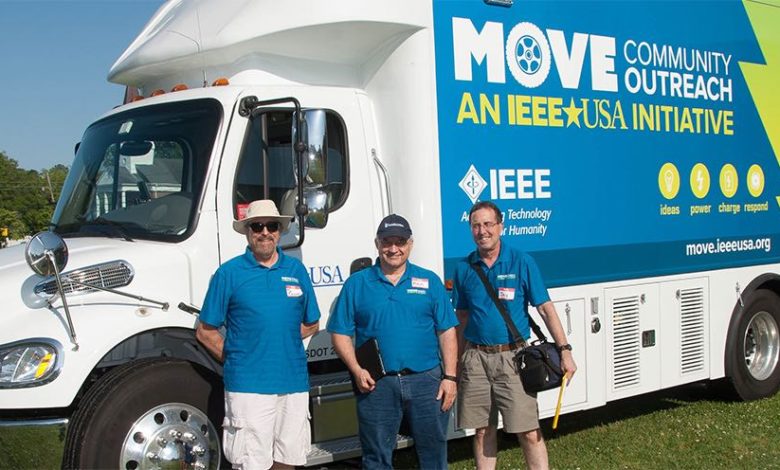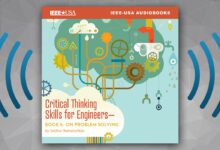
If a fire breaks out in your home, could you and your family escape safely? Could you do it in less than two minutes?
Not everyone does.
Every day, an average of 36 people suffers injuries or death in a U.S. home fire. Seven die. More people die in home fires than those killed in tornadoes, floods, and other natural disasters.
IEEE-USA is doing its part to reduce these numbers.
On 14 May, IEEE-USA’s new power and disaster relief Mobile Outreach Vehicle (MOVE) was on hand to help make residents of Duplin County, N.C., safer from home fires. Partnering with American Red Cross volunteers from the Eastern North Carolina Region, the team installed 503 home smoke alarms.
The MOVE truck is designed to travel to communities ravaged by natural disasters and infrastructure failures. Through its solar roof panels and wireless communications technology, the vehicle can provide rechargeable power banks, real-time survivor information and Wi-Fi, until regular electricity and data services are restored.
IEEE-USA volunteers Tim Forrest, Ken Pigg and Jay Diepenbrock (pictured above) deployed the MOVE vehicle in Duplin County to serve as a command center. It supplied power for Red Cross personnel to charge their cell phones, hand radios and laptop computers. Office space inside the truck was also provided, as was Wi-Fi for real-time data entry.
It was MOVE’s first service-oriented deployment.
“This type of event was a perfect match for our capabilities,” MOVE Program Director Mary Ellen Randall said. “We’re proud that we have a very useful solution to help our communities. As the IEEE tagline says, we are truly “advancing technology for the benefit of humanity.'”
Preventing Fires, Saving Lives
In addition to installing smoke alarms in your home, the Red Cross recommends they be tested once a month. If they’re not working, the batteries should be replaced. Every 10 years you should get new smoke alarms.
It’s also a good idea to have a fire-escape plan and to practice your two-minute fire drill twice a year.
The Red Cross says, “The most effective way to protect yourself and your home from fire is to identify and remove fire hazards. Sixty percent of house fire deaths occur in homes with no working smoke alarms. During a home fire, working smoke alarms and a fire escape plan that has been practiced regularly can save lives.”
For more fire-safety and prevention tips, see https://rdcrss.org/1suUwPY.
Bringing MOVE Concept into Focus
Just before Randall became IEEE Region 3 director in January 2014, she and other southeastern United States members began thinking about making a meaningful difference in people’s lives.
“I was about to start my directorship and wanted to show our members in the region how vast IEEE is,” Randall said. “We have such a wealth of ideas in so many different technical areas, so I was looking for a big project to engage people. Being able to go out and help people after something tragic happened, and using our special skills, was a very attractive idea.
“So I started floating it with some of the leaders in our region. We started kicking around ideas and came up with this idea of going out with what became the MOVE vehicle.”
Randall and other Region 3 leaders then approached IEEE to help them find a focus group. They found Superstorm Sandy survivors, with a couple who had also been through Hurricane Katrina.
“We discussed our concept with the focus groups, and they rated it very highly,” Randall said. “They helped us to refine [the idea] and find a niche–because we didn’t want to do what everyone else was doing. We wanted to do something significant and special to help people.”
Sandy victims said losing the ability to communicate with family and friends because of dead cell phone batteries was tough to cope with after the hurricane.
“Having the ability to communicate with loved ones after an ordeal such as a tornado, hurricane or building collapse can help to reduce the feelings of loneliness and isolation that often accompany such tragedies,” Randall said. “And knowing whether you should leave a disaster zone, or stay, helps people feel a little safer.”
In a recent interview with Colonel Mason of the ScienceNews Radio Network, Randall discussed in greater detail how the MOVE truck can assist storm survivors.
Promoting STEM Literacy
The vehicle also travels to such places as fairs, libraries and sporting events to promote STEM education. Its first such gathering was in Cary, N.C., in April, and attracted about 110 people. A number of IEEE members also signed up for MOVE training.
Butch Shadwell recently took the truck on a 10-day tour to several schools in Florida. He has developed a circuit that children can use without soldering, and he is working on a PowerPoint to explain the vehicle’s onboard technology to first-graders.
Partnering with American Red Cross
IEEE-USA volunteers took delivery of the truck in March. It debuted to the public at IEEE Region 3’s SoutheastCon in Norfolk, Va., on 2 April. The American Red Cross, Eastern North Carolina Region, is IEEE-USA’s program partner.
Dr. Gregg Vaughn, Region 3 director-elect, designed the on-board distribution and management system. Shadwell designed the power bank recharging system.
Before MOVE volunteers are deployed to a disaster area, the Red Cross must ask them to do so. Barry Porter, regional chief executive officer of the Red Cross in Raleigh, N.C., said he is pleased to be working with IEEE-USA.
“As the nation’s lead volunteer disaster relief agency, we are delighted to be partnering with IEEE members on this major new initiative,” Porter said. “Supporting the communication, power and information needs of a community after a major disaster is vital to providing a path to recovery.”
To donate to or volunteer for the MOVE program, go to https://move.ieeeusa.org.






